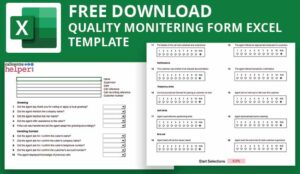When you consider the value consumers place on customer service, it’s easy to see why call quality monitoring is an integral part of call centre workflow. You might even say it is the lifeblood of a call centre operation.
According to a report conducted by customer support platform developers, over 90% of consumers say they will stop buying from a company after three (or fewer) poor customer service experiences. This highlights precisely where your customers place customer service when it comes to brand loyalty — three strikes, and you’re out.
While top-tier performance is the goal, consistency is equally important. Call quality monitoring forms, or QA forms, help QA managers assess agent performance and measure their success on quality, consistency, and adherence to your call centre’s service standards.
These forms use pre-set criteria to score your agents on how well or poorly they handle customer interactions. They are invaluable tools for enhancing transparency within your contact centre and, more importantly, ensuring consistent, high-quality customer service.
Creating an effective QA form for your call centre will depend on your specific goals and benchmarks. Most importantly, your form should align with your call centre’s agents, communication channels, training courses, and general best practices.
Setting Your Call Centre Up for Success
Before creating the actual QA form, let’s look at a few tips that are worth implementing that will help you produce the best possible results.
Get Insights From Your Agents
No one knows or understands the day-to-day specifics and the ever-evolving demands of your customers like your call agents. Rather than leaving form development up to your leadership teams, involve your agents in the process. You can even sit in on a few calls to understand exactly what their job entails and ensure your QA form addresses real-world situations and issues.
Separate Skill Gaps From Process Inefficiencies
More often than not, poor performance is not due to a lack of skill but rather an overload of frustration. Understanding that can be a real eye-opener and allow you to address problem areas more directly.
Evaluate Past Performance
Another exercise worth its weight in gold when it comes to creating a great QA form is call evaluation, which entails examining and analyzing your best and worst calls. Evaluating standout calls, as well as those that went awry, can help you create right-fit metrics for your QA form.
The Essential Elements of a Call Centre QA Form
While we mentioned that your call monitoring form should be customizable, four essential areas need to be a part of your QA form:
- Soft Skills: Your call monitoring form should have a section that allows you to test your agent’s communication skills, professionalism, ability to gain customer trust, product knowledge, and problem-solving.
- Processes: The form should answer the question, how well did your agent follow all of the correct processes for customer service?
- Compliance: Compliance is an increasingly serious risk for most call centres. Your call monitoring form should help you determine if your agent passed or failed basic compliance requirements.
- Outcomes: The key to measuring outcomes within your call centre monitoring software is putting all customer insight on one page. You should include the outcomes from your soft skills, process, and compliance monitoring in a single dashboard.
Let’s examine each of those areas up close:
1. Soft Skills
Soft skills are perhaps the most crucial skill for a call centre agent to have. While training can help agents develop hard skills like learning a new software system, people skills are mostly inherent through life experiences and general disposition. It’s much tougher to teach someone how to empathize with a customer than to teach them about a new tool or process.
Your agents’ soft skills include their ability to empathize, act professionally, be courteous, and gain customer trust. You can also evaluate their overall product knowledge and problem-solving skills in this section.
To measure soft skills on a QA form, include questions such as:
- Did the agent display active listening skills?
- Did the agent build rapport and show understanding of the client?
- Was the agent’s tone and pitch appropriate to the mood of the call?
- Did the agent summarize the follow-up plan?
- Was the agent professional at all times?
2. Processes
In a best-case scenario, all of your call centre agents want to be exceptional at what they do. Unfortunately, there are times when a poorly designed process prevents agents from achieving this goal.
So how do you make sure your processes are working?
First off, don’t ever be complacent about your processes, especially when they have been in place for a long time. Take time to routinely examine if your current processes are working, then reflect these adjustments on your QA form to ensure your agents are following all the correct processes. The exact processes you decide to include on your form will vary, but examples include:
- Did the agent follow the correct call routing process?
- Did the agent follow our compensation process?
- Did the agent terminate the call correctly?
- Did the agent update the notes in the CRM case?
Be sure to take your manager’s hat off from time to time and look at your processes through the lens of your agents and customers. When something is failing your agents, it will fail your customers, and eventually, your call centre as a whole.
3. Compliance
While compliance issues may have no direct impact on the customer experience or overall satisfaction, failure to address them can have serious negative legal ramifications. Compliance in call centres is all about protecting customer data, protecting credit card data, and meeting the legal requirements on cold calling.
As a result, there are a few “must observe” compliance regulations call centre agents must follow. Here are a few ways they could appear on your QA form:
- Pass/Fail: Identification and validation
- Pass/Fail: Identifying and handling vulnerable customers
- Pass/Fail: Seeking permission for a credit check
4. Outcomes
Your outcomes essentially assess whether all of the above (soft skills, processes, and compliance) are being met. This should be in a dedicated area on your QA monitoring form.
Seeing as there are many possible outcomes for a call, the ones you choose to monitor will depend on the type of business you’re running.
Some samples of outcome metrics should include:
- Number of calls made
- Length of time of calls
- How well did the agent meet their “greeting” goals?
- How many “soft skills” did the agent successfully demonstrate?
- Did the agent correctly demonstrate their “problem-solving abilities?”
- How well did the agent follow all of your processes?
- Was the agent fully compliant with company policies?
- Did the agent follow up with the customer at the end?
For each of these questions, your call monitoring QA form should include a way to demonstrate whether or not agents met their goals, then a more detailed look at how well they met their goals (for example, 80% satisfactory).
Lastly, there should be a section within your call centre QA software where your supervisors can write out their final thoughts on how well the agent performed.
Unlike traditional analytics tools, QA forms provide call centre managers with insights into where agents might be struggling, as well as where they are excelling. The information provided is all about making better, smarter decisions.
Effective QA forms provide oversight and insight on several call quality metrics, including diverse areas such as how the agent offered help, the way they verify customer accounts, their adherence to protocol, and their overall call handling skills.
Any exercise that enhances agent performance, increases operational efficiency, and elevates CX is worth doing, and creating a great QA form checks all those boxes.
This blog post has been re-published by kind permission of Scorebuddy – View the Original Article
For more information about Scorebuddy - visit the Scorebuddy Website
Call Centre Helper is not responsible for the content of these guest blog posts. The opinions expressed in this article are those of the author, and do not necessarily reflect those of Call Centre Helper.
Author: Scorebuddy
Published On: 12th Nov 2021 - Last modified: 16th Nov 2021
Read more about - Guest Blogs, Scorebuddy






 Scorebuddy is quality assurance solution for scoring customer service calls, emails and web chat. It is a dedicated, stand-alone staff scoring system based in the cloud, requiring no integration.
Scorebuddy is quality assurance solution for scoring customer service calls, emails and web chat. It is a dedicated, stand-alone staff scoring system based in the cloud, requiring no integration. 









